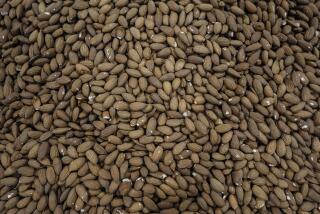Calorie counts on nutrition labels may not be as precise as you think

- Share via
Almonds used to have about 170 calories per serving. Then researchers said it was really more like 130. A little later, they said the nuts may have even less.
Calorie counting can be a simple way to help maintain a healthy weight — don’t consume more than you burn. And the calorie labels on food packaging seem like an immutable guide to help you decide what to eat and drink.
But the shifting numbers for almonds show how the figures printed on nutrition labels may not be as precise as they seem.
Last month, Kind said it was lowering the calorie counts for its snack bars, even though the ingredients weren’t changing. The company cited studies that indicate nuts have fewer digestible calories than previously believed.
Conducted by government researchers with funding from nut producers, the studies highlight the inexact method of determining calorie counts that was established more than 100 years ago.
The widely used system says a gram of carbohydrates and a gram of protein each have 4 calories, while a gram of fat has around 9. Companies can also subtract some calories based on past estimates of how much of different foods are not digested by the body.
But based on anecdotal comments, researchers suspected more of the nutrients in nuts may be expelled undigested than previously estimated.
“If they’re not digested, then maybe the calorie content is not correct,” said David Baer, a research physiologist with the Agricultural Research Service at the U.S. Department of Agriculture.
To test the hunch, Baer and colleagues gave 18 people meals with and without raw almonds and instructed them to return daily with their urine and stool packed in dry ice. The contents were analyzed to calculate that a serving of almonds has about 130 digestible calories, rather than the widely used figure of 170.
A few years later, in 2016, Baer and colleagues looked at the effects of food processing. They found cooking and grinding helped break down cell walls in almonds, freeing more calories for digestion. Roasted almonds had slightly more digestible calories than raw almonds. When the nuts were ground up into almond butter, nearly all the calories were digested.
Notably, the second study also found raw almonds had even fewer digestible calories than suggested by the first study. Baer attributed the discrepancy to variations in how people digest foods and natural differences in almonds themselves.
“It’s unlikely you’re going to get the exact same number every time you repeat the experiment,” he said.
The almond studies, which were funded by the USDA and by nut producers like the Almond Board of California, are among several on the digestibility of nuts for which Baer was a co-author. Another study he worked on last year found that cashews had fewer calories than previously estimated. That work was funded by the Global Cashew Council.
Despite his findings, Baer said he thinks the calorie counts used for most other foods are fairly accurate. And even though the U.S. Food and Drug Administration lets companies use different methods to determine calorie counts, the agency says products aren’t supposed to have more than 20% more calories than what’s stated on labels.
That’s why health experts said the calorie counts on nutrition labels are still valuable: They offer general guidance for people trying to keep their weight in check.
But it’s even more important to pay attention to your overall diet and not get hung up on small caloric differences, experts said.
“That’s not what’s going to make or break someone’s attempt at weight management,” said Elizabeth Mayer-Davis, a nutrition researcher at the University of North Carolina.
Mayer-Davis said the studies on the calories in nuts wouldn’t affect her general advice that they can be part of a healthy diet. She said it’s more important to pay attention to how they’re prepared, such as whether sweeteners are added.
Kind’s founder, Daniel Lubetzky, said he hopes the studies will help overcome the reluctance some might have about eating nuts because of their relatively higher calorie counts. The studies also mean the company’s most popular bar can now drop from 200 to 180 calories, which could be a marketing advantage that sways decisions at the grocery store.
“It can’t hurt,” Lubetzky said
Mars, which took a minority stake in Kind in 2017, said it doesn’t have plans to update the calorie counts for M&M’s with almonds. The Almond Board says it’s not aware of other companies yet using the lower numbers.




